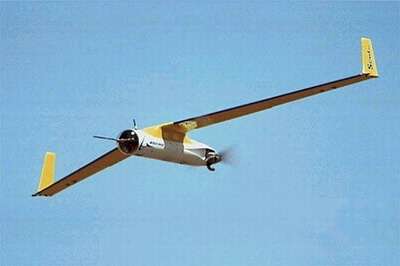USAF Test Demonstrates Near-Orbit Networking Capability
 Boeing and the US Air Force have
demonstrated for the first time how -- with advanced airborne
networking and information management technology -- a near-space
vehicle can be used as a flexible, low-cost, theater-wide
information broker that provides real-time tactical information to
ground forces enhancing their effectiveness and survivability.
Boeing and the US Air Force have
demonstrated for the first time how -- with advanced airborne
networking and information management technology -- a near-space
vehicle can be used as a flexible, low-cost, theater-wide
information broker that provides real-time tactical information to
ground forces enhancing their effectiveness and survivability.
The recent demonstration was the first in a series of
experiments dubbed Project Marti. The Marti concept seeks to
combine the wide-area coverage and loiter time of a near-space
vehicle with the sensing ability and agility of lower-altitude
unmanned air systems.
For the demonstration, Boeing's phantom works launched a balloon
as the carrier vehicle for what it calls an "airborne information
broker," an intelligent data distribution system. Then, multiple
information sources, including ground-based software clients
mimicking low-altitude unmanned aerial observation systems,
delivered near real-time imagery and data through an Internet
Protocol network to the system on the balloon. The balloon served
as a surrogate for a near-space vehicle.
The sources transmitted the data simultaneously in a format
allowing accurate tactical information to be passed efficiently
among multiple systems. The system aboard the balloon then
successfully distributed to ground stations only the data that
matched each users' subscription.
The system's goal is to provide information over a large
geographic region, beyond the reach of a single low-altitude asset,
without the need for expensive space-based assets that are often
reserved for higher priority missions.

"The challenge here is much more than just the establishment of
a high-altitude communications relay," said Patrick Stokes, Boeing
Phantom Works manager of Network-Centric Operations-related
programs. "It's really all about effectively bringing the power of
real-time information to bear within a tactical theater, and doing
so without the need for an expensive, fixed infrastructure."
To bring this communication power to the troops, Project Marti
is leveraging innovative information management brokering
techniques to provide advanced publish and subscribe capabilities
across a broad geographical region. Researchers from Phantom Works
and the Air Force Research Laboratory Information Directorate
recently conducted an initial risk-reduction demonstration of these
capabilities.
"This demonstration was the first instance of an airborne
information manager storing published UAS (unmanned aerial system)
sensor data for delivery to ground-based subscribers, who could
then utilize that data on a tactical display," said Dr. Jim
Paunicka, Phantom Works principal investigator on Project Marti.
"The subscribers need only display the data that's relevant to
their tactical missions, much in the way that an Internet user
would employ a search engine to obtain relevant information."

Boeing says future tests in Project Marti will expand the amount
and complexity of data as well as the number of assets involved.
The tests will culminate in a tactically relevant live flight
demonstration in which multiple airborne and near-space assets will
operate over an extended range to support a large number of ground
units.
During this final demonstration, planned for early 2008, live
imagery and tactical data from UAS sensors will be published to the
airborne network through an information broker on a high-altitude
surrogate near-space vehicle -- a balloon that will be launched to
about 80,000 feet. Ground units will be able to collaborate with
each other by subscribing to data relevant to their respective
missions.
Project Marti is one of several programs that support the AFRL's
Tactical Information Dominance vision to show how combined UAS and
near-space assets can provide widespread information access in
tactical operations.
 Airborne 07.11.25: New FAA Boss, New NASA Boss (Kinda), WB57s Over TX
Airborne 07.11.25: New FAA Boss, New NASA Boss (Kinda), WB57s Over TX Airborne-Flight Training 07.10.25: ATC School, Air Race Classic, Samson School
Airborne-Flight Training 07.10.25: ATC School, Air Race Classic, Samson School Airborne Affordable Flyers 07.03.25: Sonex HW, BlackShape Gabriel, PRA Fly-In 25
Airborne Affordable Flyers 07.03.25: Sonex HW, BlackShape Gabriel, PRA Fly-In 25 Airborne-Flight Training 07.10.25: ATC School, Air Race Classic, Samson School
Airborne-Flight Training 07.10.25: ATC School, Air Race Classic, Samson School Rick Kenin New Board Chair of VAI
Rick Kenin New Board Chair of VAI





